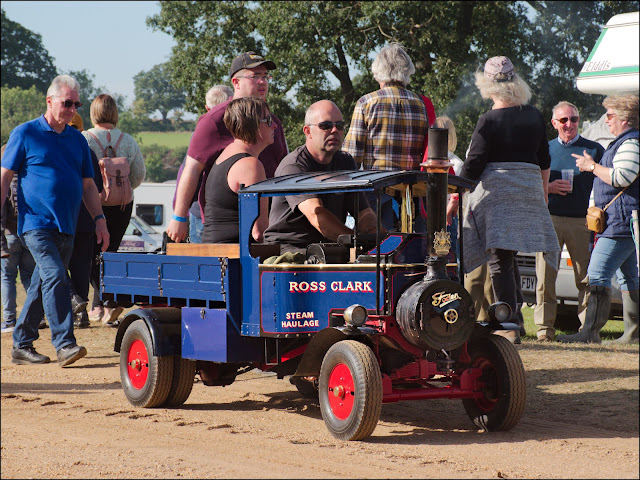While I had some internal argument with myself about going to the Bedfordshire Steam Rally recently, there was never any doubt that I'd go to Stotfold Working Steam Weekend if at all possible. Although it's fairly small it's my favourite steam event of the year. The only problem was whether I'd find anything new to put on the blog. Here are three exhibits that tempted me to linger.
The Biggest Little Sawmill
One corner of the showground is set aside for steam-driven sawmills:
First you need to select your log and move it into position using a steam crane. The beauty of this show is that you see many of the machines being used for their original purpose.
Then you need to build up a head of steam in this engine which is going to power one of the sawmill set-ups. You'll notice that it has no cab or place for the driver; that's because it's the old type of "stationary engine". That's a slight misnomer as it was obviously mobile, but needed to be pulled around by a team of horses, or these days probably another engine.
And here's the mighty steam bandsaw, which could produce boards and beams from very large lumps of wood. On the side it says "Hadrian W. Spooner & Sons" which sounds like an excellent name for a nineteenth-century entrepreneur. When I got home I Googled "Hadrian Spooner" - I mean, there can't be many folk about with that name.
Far from being a Victorian gent he turns out to be a very alive TV personality who has appeared on Scrapheap Challenge, The Biggest Little Railway In The World and other shows which highlighted his eccentric engineering expertise. I'm fairly certain he's the man in the white T-shirt in the above photos.
Meanwhile the crane is moving another log for a different saw. But I found myself more drawn to a smaller arrangement....
Meet "Steady Eddie" and his steam-powered saw-bench. As you can see he's utilising a small model steam engine to run his saw. It just shows you how much power can be generated by such tiny machines. But it's time to move on....
Another Mini Machine
Here's a charming little model of a thrashing machine. Its full-sized cousins were widely used on farms to separate the grain from the straw and chaff before the advent of the combine harvester. There's a sign to tell you its story:
"This is a fully working, 3 inch to the foot ( 1/4 size ), model of a Ransomes, Sims & Jefferies AM54 Medium thrashing machine.
It was built over a period of about 12 months, starting from
purchased drawings. However, it soon became apparent that the
drawings were both inaccurate and lacking in detail & so were
abandoned. The model was finished by studying pictures, books & the
internet, as well as climbing over a full-size machine living nearby.
All castings ( nearly 200 ) were home cast from patterns produced
by 3D printing."
And this is the little engine that powers the model (and, I presume, that's the man who built it). Although it's small, and although there are demonstrations by restored, full-size thrashing machines at most shows, I think this serves a vital educational purpose. The real things are noisy, dusty and too big to take in easily from a single vantage point, especially for little people. This one is an ideal teaching resource. It can get very cluttered and confusing around a real thrashing machine....
Memories Of Monty
There are also some exhibits which have no connection to steam. Most of these shows attract a few old military vehicles....
Impressive though some are, I rarely photograph them. Not very colourful and just not something which attracts me. And this small, wooden caravan would never have caught my eye had Les not been involved in protracted negotiations about the price of a jacket.
It's not even the original, just a replica of one which is kept at the Imperial War Museum in nearby Duxford. It was first used by General Annibale "Electric Whiskers" Bergonzoli of the Italian army. But it was stolen (or in army-speak "liberated") at the battle of Beda Fomm in Libya.
It was later used as living accommodation for General Montgomery when commanding the 8th Army's desert campaign. Churchill even stayed in it when visiting Monty. When another caravan was captured, the original of this one was then used as Montgomery's office.
And here comes Les. It turned out that they didn't have the jacket in his size anyway!
Take care.




























































